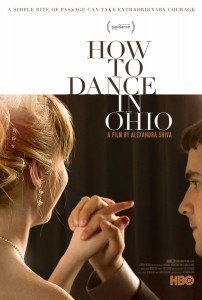The too-cool-for-schoolers can relax; this isn’t a Glee spin-off. It barely even features any dancing. Alexandra Shiva has dealt previously with the arts in her 2006 documentary, Stagedoor, which detailed the experiences of teenagers at theatre camp. In How to Dance in Ohio, she documents preparations for a social dance, organised for teens and young adults on the autism spectrum.
Shiva’s film involves an eclectic mix of characters, though she chooses to zone in on three. Marideth is a teenager who likes to keep to herself. She doesn’t look people in the eye, but she is willing to take on board others’ suggestions. Caroline is in her first year of university. She wants to become an early childhood educator and is learning Japanese, however she struggles with anxiety. Jessica is brimming with confidence, but sometimes she unwittingly offends with her honesty. Participating in a work experience program for adults with autism, she hopes to move out of home in the near future. All girls share social difficulties, but are vastly different in many other respects. The psychologist in charge tells the group at one point: “If you know one person with autism, you know one person with autism”. Shiva’s choice to use all girls as her case studies is an unusual one, and the inclusion of a male character may have added more.
Though such an event is often one of the highlights of a typical young person’s calendar, for individuals with autism a dance serves up a multitude of challenges. Preparations for the dance include learning how to initiate conversation, finding a date (optional), and learning a few basic dance moves. We are invited into the homes of our three leading ladies, and are witness to a range of parents with differing emotions on display. One mother is brimming with pride and joy; another tries to maintain a smile while she worries about her daughter’s future; the other looks ready to cry at any moment.
There are, unsurprisingly, moments of sadness as we are made to ponder about the future of these individuals. But with it, there is plenty of light. There are frequent moments of hilarity – Jessica in particular produces multiple laugh-out-loud moments – and the film’s subjects are never the butt of the joke. When the audience laughs, it is with affection, and also perhaps recognition for those who know someone with autism. Though the road ahead will no doubt be a challenging one, the film offers hope, and with it a whole lot of joy.
How to Dance in Ohio screened at the Melbourne International Film Festival.





